Brandon Howard’s Analysis: Is WWE Business Down?
An analysis of attendance estimates suggests WWE’s live event business for September 2017 was not far off from what it usually is for that month. Turnouts for SmackDown TV tapings however are arguably disappointing in light of the brand split that’s been underway since July 2016, an effect that may be due to the absence of John Cena.
Meanwhile a study of Google searches and Wikipedia pageviews hint at a recent, marginal decline in overall product interest that is not merely seasonal. However television viewership of RAW and SmackDown in September 2017 was on par with that of September 2016.
A rash of fan photos from WWE live events have emerged online lately, showing sparsely-attended arenas, particularly at TV tapings for RAW and SmackDown.
When we look at attendance estimates extracted from the Wrestling Observer Newsletter, we find average RAW TV attendance for September 2017 (7,000) is almost identical to that of the same month in 2016 (7,100).
Average SmackDown TV attendance in September was 3,900, well down from 5,900 the prior year. In September 2014, average SmackDown TV attendance was even lower: 3,700. It’s arguable though that attendance was up in September 2016 due to the fresh brand split and that the increase in attendance for that month is a benchmark the brand fell well short of this year.
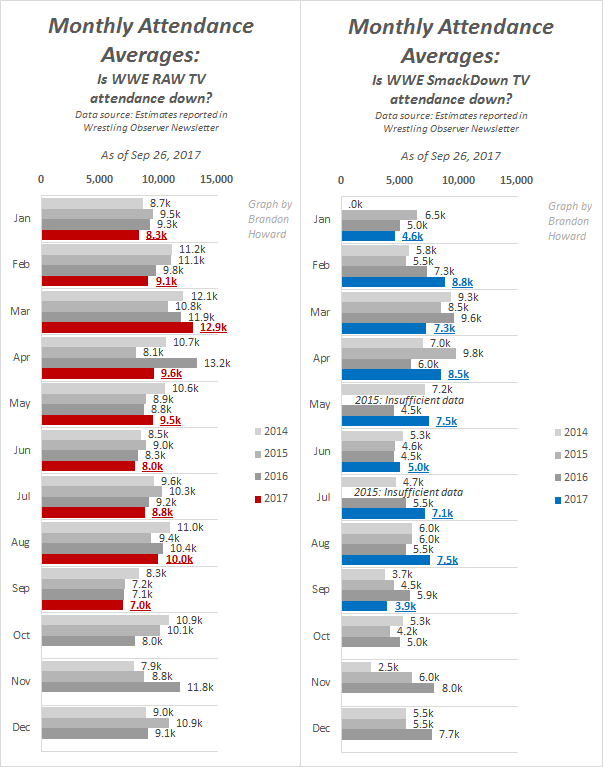
It should be noted attendances extracted from the Observer are estimates, not actuals. We are also missing some data points as a minority of events did not have an attendance reported. We have data for the vast majority of RAW TV events. About half of the data for SmackDown TV events from before the brand split is missing, but most of the data after the brand split has been reported. The vast majority of North American house show attendances are present in the graphs referenced below also. As I discussed with Chris Harrington on the most recent episode of Wrestlenomics Radio, the margin of error may be larger than the differences we would consider significant.
The most likely cause of the drop in attendance seems to be the absence of John Cena, who switched to the RAW brand on August 21, the night after Summerslam.
Jinder Mahal’s widely-panned title reign is another popular scapegoat. However he’s been champion since May 21. Following his title win, SmackDown TV attendance was actually up from prior years in June, July and August. It’s only since Cena’s departure from the brand that attendance has declined.
A study of house show business doesn’t strongly support a notion that WWE business is down. Average attendance for North American house shows are in fact down in most months from prior years. While running more events due to the brand split, however, total attendance is likely up and live event revenue is likely up due to rising ticket prices and NXT events. We'll learn more details on total attendance and live event revenue when WWE releases its Q3 report, probably sometime later this month.
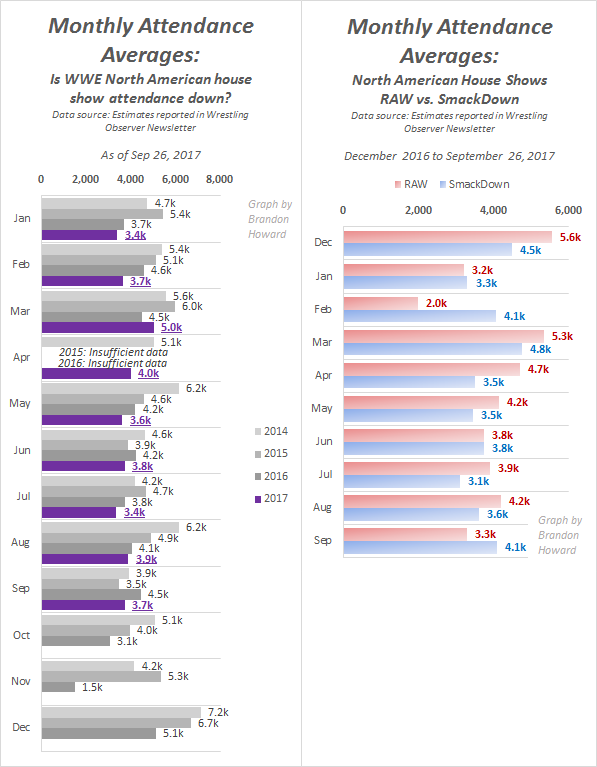
WWE’s Q2 report showed total attendance for the first six months of 2017 to be at 1,146,000. That’s up from 1,044,900 in the same period in 2016. Revenue from live events was $82 million in 1H2017, versus $75 million in 1H2016. Average ticket prices were actually slightly down in 1H2017, at $63, down from $64 in 1H2016. Ticket prices for international events though were up significantly: $74, compared to $60.
It’s interesting to note that North American SmackDown house shows beat that of RAW in September, even as SmackDown has the disadvantage of running house shows on Monday nights, and even as the blue brand was without Cena and still with a perceptibly weak champion in Mahal.
Even television viewership is up more often than not since August.
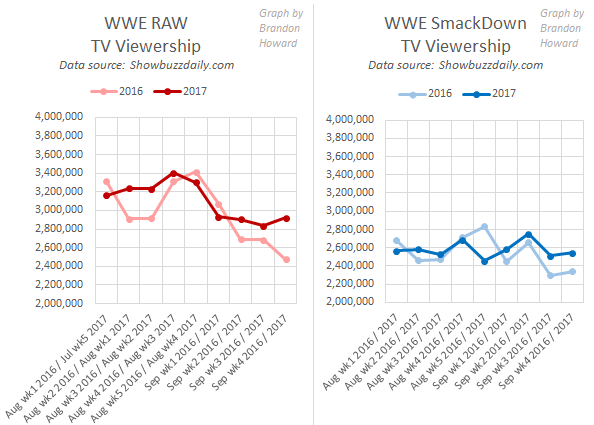
I find this impressive considering that the effects of new media, in my view, put more recent viewership numbers at an inherent disadvantage. That’s especially so since we are looking at the viewership metric (all viewers over the age of 2) here as opposed to household TV ratings, which factor in available households, which would offset at least some of the effects of cord-cutting.
There are faint signs here that the plunge in traditional TV viewership might finally be plateauing, but we’ll have to see how that unfolds as the NFL season wears on. It certainly doesn’t hurt WWE programming this year is lacking any challenge from television coverage of a contentious U.S. presidential election.
Google searches and Wikipedia pageviews tell a different story. I think these metrics are worthwhile for considering overall interest in WWE because they’re relatively mature, as opposed to other digital metrics like video views, which still seem to be growing at a rapid rate throughout media as broadband access increases throughout the worldwide. Google search data we are considering here from Google Trends are also adjusted for total searches overall, which should adjust for changes in overall use of Google.
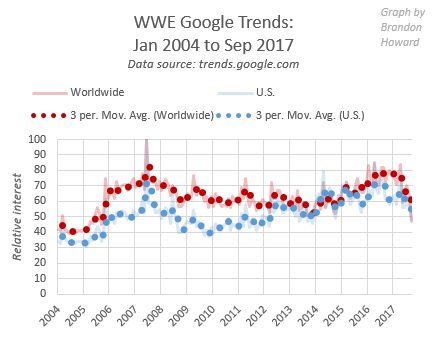
Based on a 3-month moving average, Google searches in both the U.S. and worldwide are lower than they were in September of recent years. The most recent 3-month average is the lowest point of the last few years, but still above quarters in years like 2009, 2010, 2011, 2012 and 2013: years when business was about as stable as it is now.
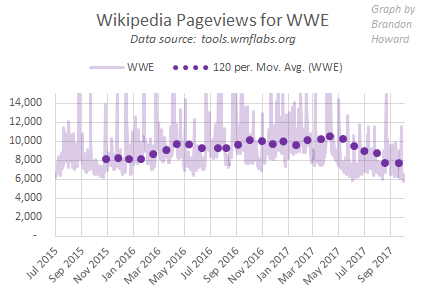
Pageviews for the Wikipedia page for WWE support the notion of a mild decline in interest. A moving 120-day average puts pageviews at their lowest point in the last few years. This data only goes back to July 2015.
Whether the Google and Wikipedia metrics are a foreboding signal of a greater decline to come remains to be seen. With Cena perhaps taking an even more reduced role going forward, attendance may continue to slightly underperform. Even without Cena, though, I expect on the whole WWE’s live event business to remain healthy, with average attendances down but total attendance, ticket prices and event revenue up for the foreseeable future.
Follow Brandon on Twitter @BrandonThurston. Email him at brandon@fightful.com.



